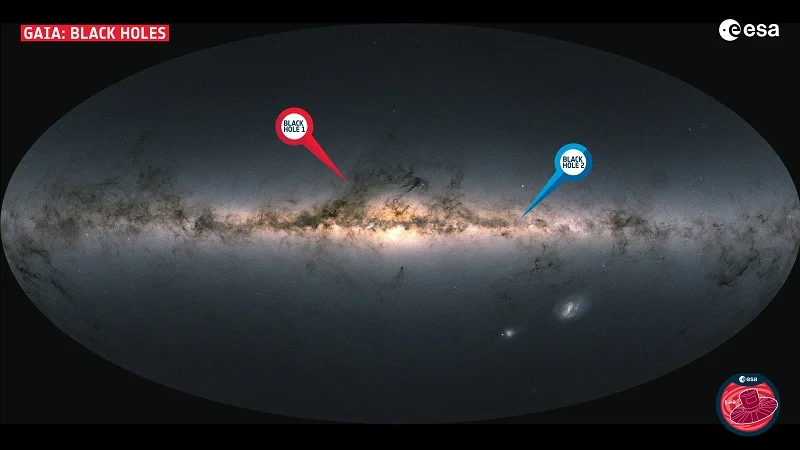Gaia discovered a new family of black holes
- April 3, 2023
- 0
Using data from the ESA Gaia mission, astronomers have discovered not only the closest black hole to Earth, but also the second-closest black hole. Black holes, Gaia BH1
Using data from the ESA Gaia mission, astronomers have discovered not only the closest black hole to Earth, but also the second-closest black hole. Black holes, Gaia BH1

Using data from the ESA Gaia mission, astronomers have discovered not only the closest black hole to Earth, but also the second-closest black hole. Black holes, Gaia BH1 and Gaia BH2, are only 1,560 light-years away in the constellation Ophiuchus and 3,800 light-years away in the constellation Centauri, respectively. In galactic terms, these black holes are in our cosmic backyard.
The two black holes were discovered by studying the motion of their companion stars. A strange “oscillation” in the motion of the stars in the sky indicated that they were orbiting a very massive object. Either way, the objects are about ten times heavier than our Sun. Other explanations for these massive companions, such as binary star systems, have been rejected as they do not appear to emit any light.
All black holes known to astronomers until recently were discovered by light (usually X-rays and radio waves) emitted from material falling into them. New black holes are truly black and can only be detected by gravitational influence. The distance from the stars to the black hole and the orbits of the stars around them are much longer than any other known black hole and star pairs. These closer star-black hole pairs, called X-ray binaries, tend to be very bright in X-ray and radio light and are therefore easier to find. But new discoveries show that black holes are more common in more extensive binary systems.
“What distinguishes this new group of black holes from the black holes we already know is their large distance from companion stars. These black holes are probably X says it has a completely different history of formation than -ray binaries.Astronomy in Heidelberg, Germany. The research is published in the journal Monthly Notices of the Royal Astronomical Society.
Black holes were discovered using Gaia data. Gaia precisely measures the position and motion of billions of stars. The movement of stars across the sky can provide important clues about objects gravitationally affecting these stars. These objects may include other stars, exoplanets, and black holes.
“The accuracy of the Gaia data was crucial to this discovery. Black holes were found by detecting the tiny wobbles that a companion star makes as it orbits. No other instrument can make such measurements, says Timo Prousti, ESA’s Gaia Project Scientist.
Gaia provided accurate measurements of motion in three directions, but additional radial velocity measurements were needed to better understand how stars are moving away from us. Ground-based observatories provided them with the newly discovered black holes, and this provided the final clue for astronomers to conclude that they had discovered black holes.
Black holes are usually not completely invisible. It can emit radio and X-ray light when material falls on them. For Gaia’s second black hole, NASA’s Chandra X-ray Observatory and the MeerKAT ground-based radio telescope in South Africa looked for this light, but were unable to detect any signal.
“Although we didn’t find anything, this information is incredibly valuable because it tells us a lot about the environment around the black hole. Many particles leave the companion star in the form of a stellar wind. But because we don’t see it, seeing any radio light tells us a great deal about the black hole. “We don’t know why, but we want to find out,” says Yvette Sandes, an astronomer at the Harvard-Smithsonian Center for Astrophysics in the US who helped discover the second black hole.
The new type of black hole emits no light, making them nearly invisible, presumably because they are much further away from their companion stars. Gaia BH1 and Gaia BH2 have the most widely spaced orbits of any known black hole. The fact that these are also the closest known black holes to Earth indicates that many other similar black holes in large binary systems are still waiting to be discovered.
“This is very exciting because it now means that these black holes in wide orbits are actually common in space – more common than binary systems where the black hole and star are closer together. But the problem is to detect them. The good news is that Gaia is still collecting data and the next The data release (in 2025) will include many more of these stars with mysterious black hole companions,” explains Yvette.
The next version of the Gaia data will be based on 66 months of observations and will include enhanced information about the orbits of the stars. Meanwhile, astronomers will be busy figuring out where these wide-orbiting black holes come from.
“We suspected that black holes might exist in more extensive systems, but we weren’t sure how they formed. Their discovery means we need to tailor our theories about the evolution of binary star systems. How these systems form is not yet clear,” said Karim El-Badri.
“The Gaia Data Processing and Analysis Consortium is developing methods for identifying astrometric binaries with compact companions. We hope to present a good candidate example in the next Gaia data release,” said team member Tsevi Maze of Tel Aviv University. The scientific community hopes this new dormant black hole population will expand further.
Source: Port Altele
As an experienced journalist and author, Mary has been reporting on the latest news and trends for over 5 years. With a passion for uncovering the stories behind the headlines, Mary has earned a reputation as a trusted voice in the world of journalism. Her writing style is insightful, engaging and thought-provoking, as she takes a deep dive into the most pressing issues of our time.